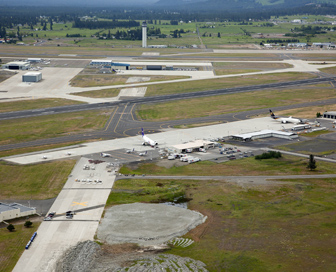




 |
Runway Line of Sight and Related Work
“The completion of this project was instrumental in allowing Phase 2 of the Runway Line of Sight project to proceed and to be funded and completed within 5 months. It was designed in one month with three types of specifications and various designers from around the country. It required daily onsite monitoring of construction activities, which resulted in a quality project at the end.”
Jeff Jurgensen OAC Project Lead
|
The VisionThe Spokane International Airport (SIA) is governed by the FAA with regards to regulation and operation of air traffic. The current runway 3-21 did not meet FAA specifications for visual line of sight for airplanes at opposite ends of the runway. Studies determined that SIA needed to raise the 3000 ft. of the NE end of the runway in order to meet this requirement. Accompanying the requirement to modify the runway were new requirements regarding roadways next to taxiways, building setbacks, etc. A determination was made to re-route the perimeter road around the airfield and construct a new building to house the approach lighting system with sequenced flashing lights (ALSF) controls to the north to facilitate the setback requirements.
SIA determined this work needed to be completed within the summer construction season. With funding and time being issues, they decided to break the project into two bid packages. Bid Package 1 (BP1) included earthwork, electrical infrastructure, and limited paving to support Bid Package 2 (BP2). BP2 includes paving and electrical equipment to support airport lighting.
The RealityBP1 constructed a new glycol facility pad and relocated the existing tanks for the airlines, as well as the heated water cabinets. This was a critical item to complete in the first 8 weeks of the project to meet FAA requirements for deicing capabilities by October 1st of every year in that region. Bad soils and issues with relocation of an unknown waterline hampered these efforts, and OAC worked with SIA in creating workarounds to allow access to the existing tanks while we constructed the new pad.
The new ALSF Building housing the airfield lighting control equipment was also constructed. If this equipment and building was not functioning or ready when BP2, started it could delay the entire BP2 project. BP2 is starting in April of 2011 and must be complete in August 2011 so that air traffic is not affected through the winter.
A new Regulator building was also constructed to house regulators for lighting systems on the runways and taxiways. The completion of this facility was is instrumental in the successful completion of BP2 as new equipment was ordered by the FAA and scheduled for delivery to the facility with no backup storage facility. If this building was not completed on time, it would adversely impact the completion of BP2, thereby impacting the airport funding and operation over the next year.
The Details
The Challenges
The OutcomeSIA was able to complete the BP1 project ($3.2M) in 10 months. This greatly reduced the pressure on the BP2 contractor to complete that scope of work ($20M) in the 5 month construction window available. If the airport would not have separated the work scopes, there was a chance they would not have received all of the funding necessary to complete the work, and even greater chance the work would not have been completed on time to open the runway completely in August 2011.
OAC is providing full construction management services to SIA, contract administration; change order identification and negotiation; construction observation and documentation; approval of payment applications; monitoring of construction schedules, coordinating on-site activities with the airport operations and facilities maintenance group to minimize the disruptions to the airfield, and preparation of reports to SIA and its board. |